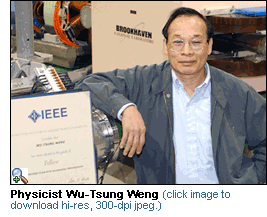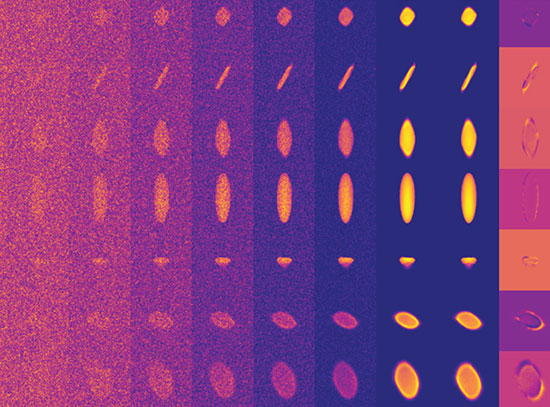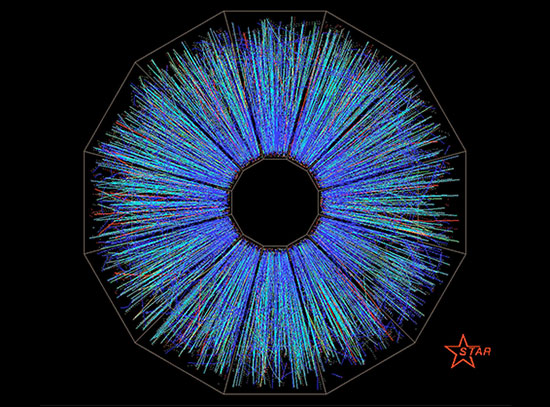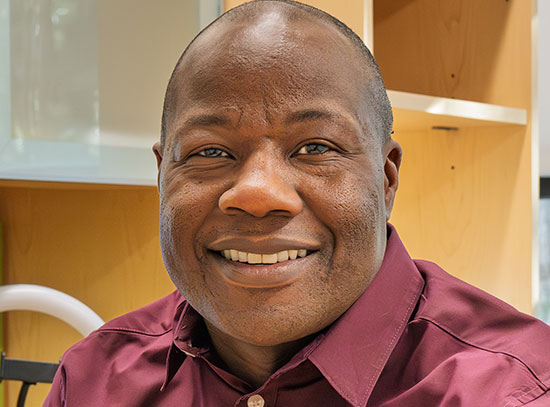Brookhaven Lab Physicist Wu-Tsung Weng Elected Fellow of the Institute of Electrical and Electronics Engineers, Inc.
January 24, 2004
Upton, NY - Wu-Tsung Weng, head of the Center for Accelerator Physics at the U.S. Department of Energy's (DOE) Brookhaven National Laboratory, has been elected a 2004 Fellow of the Institute of Electrical and Electronics Engineers, Inc. (IEEE).
IEEE is a worldwide organization with more than 350,000 members, and the honor of being named a Fellow is reserved to no more than one-tenth percent of the total voting institute membership. Weng is among 260 members who have been chosen as Fellows for 2004. He is cited for "leadership in particle accelerator development."
"I am pleased to be recognized by my peers in IEEE," Weng said. "I hope to continue to contribute to both accelerator research and the society's professional activities in the future."
Weng was in charge of the $32 million Accumulator-Booster project at Brookhaven from 1987 to 1991. Funded by the Department of Energy's Office of Science, the Booster is a particle accelerator that injects heavy ions into the Laboratory's Alternating Gradient Synchrotron (AGS), which, in turn, injects them into Brookhaven's newest accelerator for nuclear physics research, the Relativistic Heavy Ion Collider.
Thanks to Weng's design and his leadership as head of Brookhaven's Accelerator Division from 1991 to 1994, in 1995 the Booster increased the intensity of protons in the AGS to 70 trillion particles per pulse, which is still a world record. This increase in particle intensity is important for high energy physicists because they need ever-larger numbers of protons for their experiments, such as the muon g-2 experiment, from which the latest results challenge the so-called Standard Model of particle physics.
From 1996 to 2002, Weng worked on the design and construction of the $120 million accumulator ring system for the Spallation Neutron Source (SNS), being built at DOE's Oak Ridge National Laboratory in Tennessee. The accumulator ring will bunch and intensify a proton beam for delivery onto a mercury target to produce pulsed neutron beams. Expected to be completed by 2006, the SNS will provide the most intense pulsed neutron beams in the world for scientific research and industrial development.
As an active IEEE member, Weng was conference chair of the 1999 Particle Accelerator Conference in New York City, which attracted over 1,300 researchers from around the world, and he is currently a member of the committee that is organizing a similar conference in 2005 to be held in Knoxville, Tennessee. Also, from 1990 to 1993, Weng was chair of IEEE's Particle Accelerator Science and Technology Committee, which, in conjunction with the American Physical Society's Division of Physics of Beam, co-sponsors the biannual Particle Accelerator Conferences.
Weng earned a B.S. in electrical engineering from National Taiwan University in 1966; an M.S. in physics from National Tsing-Hua University, Taiwan, in 1968; and a Ph.D. in physics from Stony Brook University in 1974. He then took a postdoctoral position in nuclear physics at the University of Arizona, Tucson, from 1974 until 1977, when he joined Brookhaven as an accelerator physicist. In 1980, he became head of the Accelerator Physics Section of the Laboratory's Accelerator Department, and, in 1983, he went on to become an accelerator physicist at the Stanford Linear Accelerator Center to participate in the construction of the Stanford Linear Collider project. Weng returned to Brookhaven in 1987 as a senior physicist, and he became head of the Center for Accelerator Physics in 2002. Weng frequently served as technical consultant in many DOE reviews of U.S. accelerator projects, and he also was a machine advisory committee member of various accelerator projects in Canada, China, Europe, and Japan.
Weng has been a Fellow of the American Physical Society since 1992, and he received the Y.T. Lee Foundation for the Advancement of Outstanding Scholarship Award in 1995, in Taiwan.
2004-10144 | INT/EXT | Newsroom










